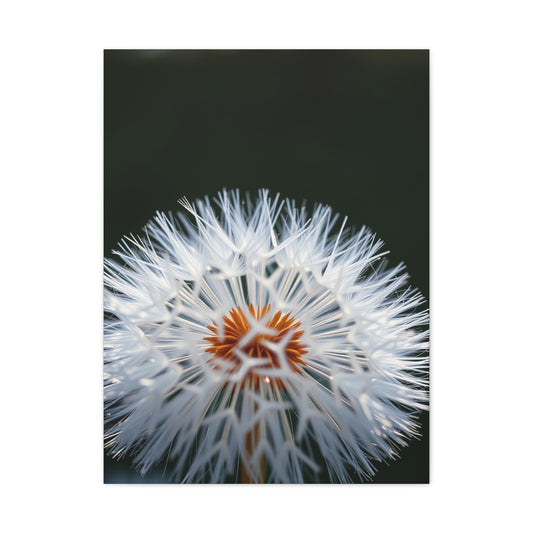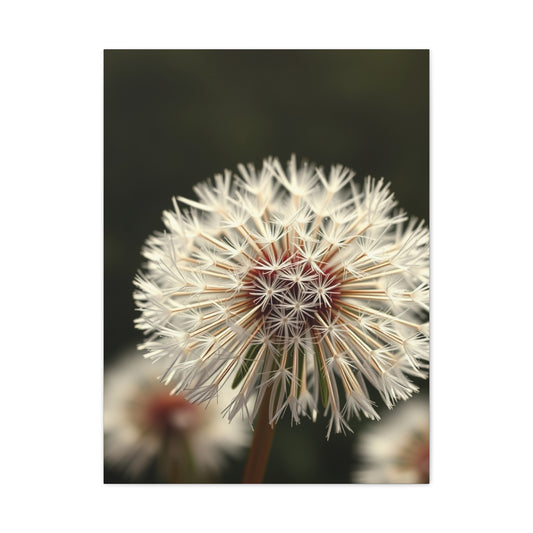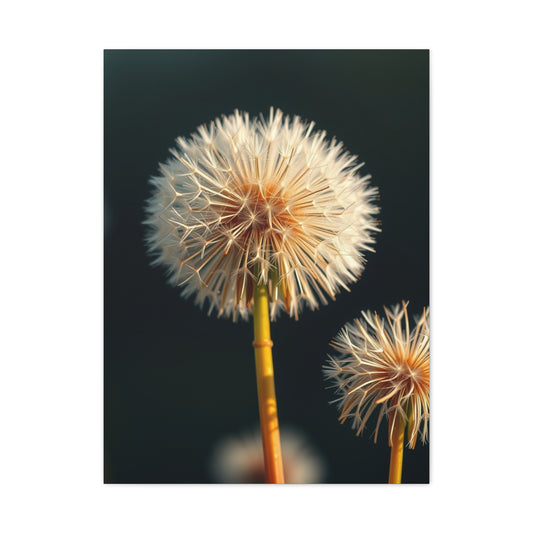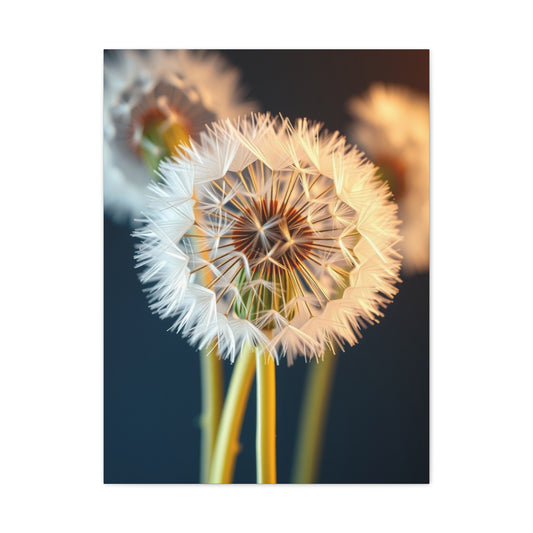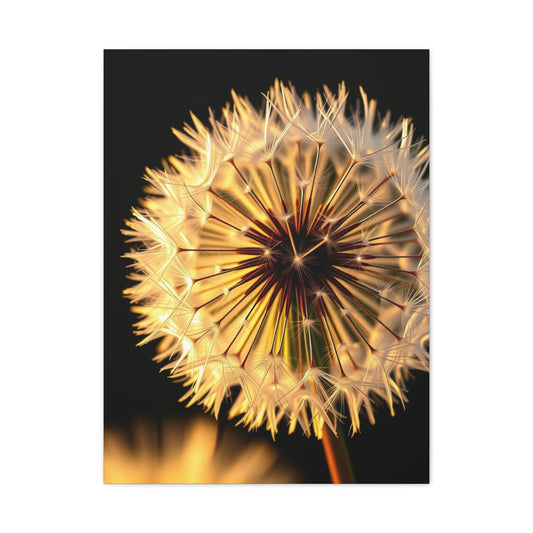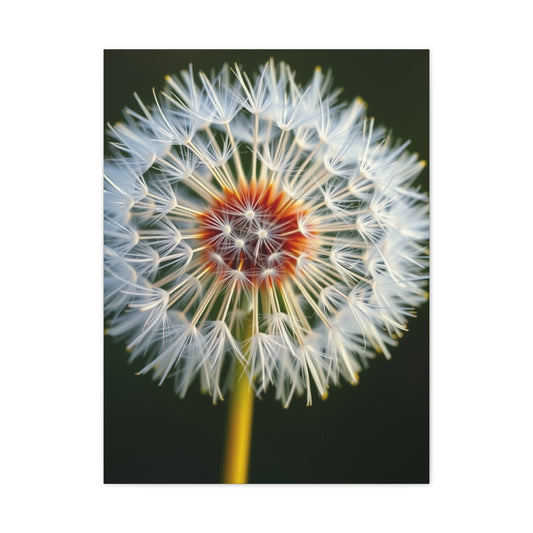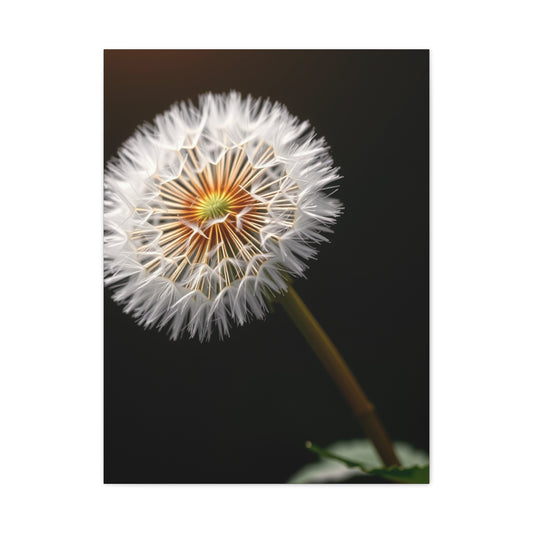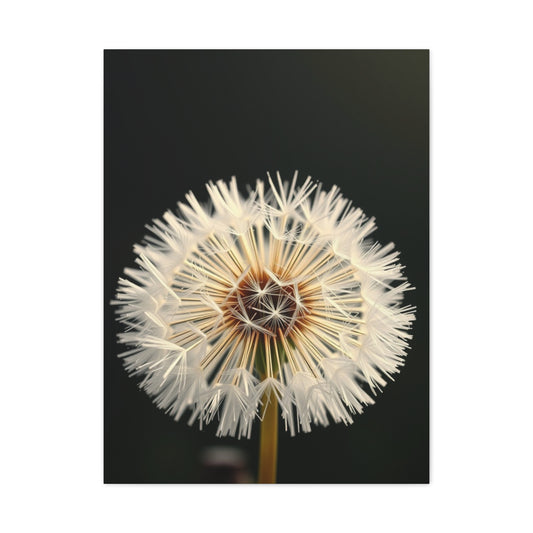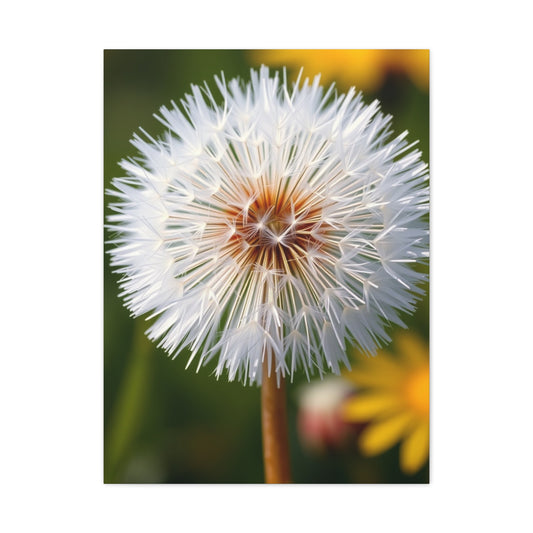The Complete Guide to Dandelion Wall Art: Transforming Spaces with Nature's Delicate Beauty
In the realm of interior design, few botanical elements capture the imagination quite like the dandelion. These ethereal wildflowers, with their gossamer seeds dancing on invisible currents, have transcended their humble origins to become icons of transformation, hope, and natural beauty in contemporary home decor. Dandelion wall art represents more than mere decoration; it embodies a philosophy of finding extraordinary beauty in the most ordinary moments of life.
The enchanting appeal of dandelion artwork lies in its remarkable versatility and universal resonance. Whether rendered in delicate watercolors that seem to float across the canvas, bold black silhouettes that command attention, or intricate line drawings that invite contemplation, dandelion motifs possess an inherent ability to infuse any environment with a sense of wonder and tranquility. This comprehensive exploration delves into the multifaceted world of dandelion wall art, examining how these seemingly simple botanical subjects can revolutionize interior spaces while reflecting deeper human connections to nature and transformation.
The phenomenon of incorporating dandelion imagery into home decor has evolved from a niche artistic preference to a mainstream design movement. Contemporary homeowners increasingly gravitate toward nature-inspired elements that provide respite from the digital overwhelming of modern life. Dandelion wall art serves as a bridge between the natural world and interior environments, offering viewers a moment of contemplative pause amid their daily routines.
Discovering the Enchantment of Dandelion Artwork in Interior Design
The magical allure of dandelion artwork emanates from its unique ability to capture fleeting moments of natural beauty while simultaneously conveying profound emotional resonance. Unlike conventional floral motifs that often emphasize bold colors and dramatic forms, dandelion art celebrates subtlety, delicacy, and the ephemeral nature of beauty itself. This distinctive characteristic makes dandelion wall art particularly effective in creating atmospheres of calm reflection and gentle inspiration.
When examining the aesthetic appeal of dandelion artwork, one discovers layers of visual and emotional complexity that extend far beyond surface beauty. The intricate architecture of dandelion seed heads, with their perfectly symmetrical spherical formations and gossamer parachute-like structures, creates natural mandalas that speak to humanity's deep-seated appreciation for geometric harmony and organic patterns. These visual elements translate beautifully into artistic representations, whether executed in photorealistic detail or abstract interpretations that capture the essence rather than literal appearance.
The transformative power of dandelion wall art lies in its ability to alter the perceived atmosphere of a room without overwhelming existing design elements. A strategically placed dandelion print can serve as a focal point that draws the eye while maintaining harmony with surrounding decor. This quality makes dandelion artwork particularly valuable for homeowners seeking to refresh their spaces without undertaking major renovations or significant financial investments.
Contemporary artists have embraced dandelion motifs with remarkable creativity, producing works that range from hyperrealistic botanical illustrations to avant-garde interpretations that deconstruct the familiar form into abstract compositions. This diversity ensures that dandelion wall art can complement virtually any design aesthetic, from ultramodern minimalist environments to richly appointed traditional spaces. The adaptability of dandelion imagery reflects its fundamental appeal as a universal symbol that transcends cultural and stylistic boundaries.
The emotional impact of dandelion artwork extends beyond mere visual appreciation to encompass psychological and spiritual dimensions. Many individuals report experiencing feelings of peace, hope, and connection to nature when viewing dandelion art, suggesting that these images tap into fundamental human responses to natural beauty and symbolic meaning. This emotional resonance explains why dandelion wall art has become increasingly popular in therapeutic environments, meditation spaces, and areas designated for relaxation and contemplation.
Professional interior designers frequently incorporate dandelion artwork into their projects because of its remarkable ability to enhance spatial perception and create visual interest without competing with other design elements. The typically neutral color palettes associated with dandelion art make it an ideal choice for spaces where cohesion and tranquility are paramount. Additionally, the organic shapes and flowing lines characteristic of dandelion imagery can soften hard architectural edges and introduce natural movement into otherwise static environments.
Crafting Personalized Dandelion Wall Decorations Through Creative Expression
The journey of creating personalized dandelion wall art opens endless possibilities for artistic expression while allowing individuals to infuse their living spaces with deeply meaningful personal touches. Engaging in do-it-yourself dandelion artwork projects provides not only beautiful decorative results but also therapeutic benefits through the meditative process of creation itself. The accessibility of dandelion-inspired art projects makes them suitable for creators of all skill levels, from complete beginners to experienced artists seeking new challenges.
Watercolor techniques offer perhaps the most natural medium for capturing the delicate essence of dandelion imagery. The fluid, unpredictable nature of watercolor paints mirrors the organic spontaneity of dandelion seeds dispersing in the wind. Beginning artists can start with simple silhouette studies, using masking fluid to preserve white paper areas while applying gentle washes of color to create atmospheric backgrounds. More advanced practitioners might explore wet-on-wet techniques to achieve the soft, ethereal effects that characterize professional dandelion artwork.
Photography-based dandelion art projects provide another accessible avenue for creative expression. Macro photography of actual dandelions reveals intricate structural details often invisible to casual observation, creating dramatic close-up images suitable for large-scale wall displays. The key to successful dandelion photography lies in understanding how light interacts with the translucent seed structures, often requiring early morning or late afternoon shoots when backlighting can create luminous, almost magical effects.
Digital art platforms have revolutionized the creation of dandelion wall art, enabling artists to experiment with effects and compositions impossible through traditional media. Vector graphics programs allow for the creation of scalable dandelion designs that maintain crisp detail at any size, while digital painting applications provide tools for achieving photorealistic effects or stylized interpretations. The ability to easily experiment with color variations and compositional arrangements makes digital platforms particularly valuable for artists seeking to create cohesive series or explore different aesthetic approaches.
Mixed media approaches to dandelion art creation offer opportunities for incorporating actual natural elements into artistic compositions. Pressed dandelion flowers and seed heads can be integrated into collages, combined with watercolor backgrounds, or used as templates for printing techniques. These mixed media pieces carry additional significance through their incorporation of authentic botanical specimens, creating deeper connections between the artwork and the natural world it represents.
Textile-based dandelion art projects expand the possibilities for three-dimensional wall displays. Embroidery enthusiasts can create delicate dandelion motifs using French knots and flowing stitches that capture the movement and texture of seed dispersal. Fabric printing techniques allow for the transfer of dandelion images onto canvas or linen, creating textural wall hangings that add both visual interest and tactile appeal to interior spaces.
The process of creating personalized dandelion wall art often becomes as meaningful as the finished product itself. Many individuals find the meditative aspects of artistic creation particularly restorative, reporting that the focused attention required for detailed botanical artwork provides mental clarity and emotional centering. This therapeutic dimension adds value beyond mere decoration, making DIY dandelion art projects investments in personal wellbeing as well as home beautification.
Collaborative family art projects centered around dandelion themes create opportunities for shared creative experiences while producing meaningful decorative elements. Children particularly respond to the whimsical nature of dandelion imagery, often bringing fresh perspectives and uninhibited creativity to artistic interpretations. Family dandelion art projects can become cherished traditions, with annual creations marking the passage of time and preserving memories of shared creative moments.
Harmonizing Dandelion Imagery with Diverse Botanical Artwork Collections
The art of successfully integrating dandelion prints within broader floral artwork collections requires careful consideration of visual balance, thematic coherence, and aesthetic harmony. Dandelion imagery possesses unique characteristics that can either complement or compete with other botanical subjects, depending on how thoughtfully the combinations are orchestrated. Understanding these relationships enables decorators to create sophisticated, layered displays that celebrate the diversity of natural beauty while maintaining unified visual impact.
Color theory plays a fundamental role in successful botanical art combinations. Dandelion artwork typically features subtle, muted palettes dominated by whites, creams, soft grays, and gentle earth tones. These neutral foundations provide excellent opportunities for introducing complementary floral pieces that share similar tonal qualities while offering contrasting forms or textures. Pairing dandelion prints with artwork featuring pussy willows, cotton plants, or dried grasses creates cohesive collections unified by shared textural qualities and seasonal associations.
Scale relationships between different botanical artworks significantly influence the overall visual impact of combined displays. Dandelion imagery often works most effectively when it serves as either a unifying element that ties together diverse pieces or as a focal point that anchors the collection. Large-scale dandelion prints can provide dramatic backdrops for smaller, more detailed botanical studies, while smaller dandelion pieces can serve as transitional elements that bridge gaps between larger focal pieces.
Seasonal progression offers another sophisticated approach to combining dandelion art with other botanical subjects. Arranging artwork to reflect natural growing cycles creates narrative depth and temporal interest within gallery wall displays. Dandelion imagery naturally represents late spring and summer transitions, making it ideal for pairing with early spring bulb flowers, summer meadow compositions, and autumn seed pod studies. This seasonal approach transforms static wall displays into dynamic storytelling elements that celebrate the cyclical nature of botanical life.
Textural contrasts between different botanical subjects can create visually stimulating collections that maintain interest over time. The soft, ethereal quality of dandelion artwork pairs beautifully with more structured botanical subjects such as ferns, succulents, or architectural plants like bamboo. These combinations prevent botanical displays from becoming monotonous while highlighting the unique characteristics of each individual piece.
Cultural and symbolic associations provide additional layers of meaning when combining dandelion art with other botanical subjects. Dandelions traditionally symbolize wishes, transformation, and resilience, making them natural companions for other plants with positive symbolic associations. Pairing dandelion prints with cherry blossom art enhances themes of renewal and fleeting beauty, while combinations with sunflower imagery amplify messages of hope and optimism.
The integration of different artistic styles within botanical collections requires careful attention to maintaining visual coherence while celebrating diversity. Photorealistic dandelion prints can be successfully combined with impressionistic or abstract interpretations of other flowers, provided that unifying elements such as color palette, scale, or framing choices create connections between disparate styles. This approach allows for dynamic, eclectic collections that reflect sophisticated aesthetic sensibilities.
Contemporary botanical art collections increasingly emphasize environmental consciousness and sustainability themes. Dandelion artwork naturally aligns with these values through its celebration of wild, uncultivated plants that many traditional gardens treat as weeds. Combining dandelion art with pieces featuring other resilient wildflowers or native plants creates collections that subtly advocate for ecological awareness while providing beautiful decoration.
Dandelions in Contemporary Home Decoration
The symbolic significance of dandelions in home decoration extends far beyond their immediate aesthetic appeal, tapping into ancient cultural associations and universal human experiences that resonate across diverse backgrounds and belief systems. Throughout history, dandelions have embodied concepts of transformation, wishes fulfilled, resilience in adversity, and the capacity for beauty to emerge from unexpected places. These profound symbolic dimensions make dandelion wall art particularly powerful for individuals seeking to infuse their living spaces with deeper meaning and personal significance.
The most widely recognized symbolic association with dandelions centers on wish-making and hope fulfillment. This connection stems from the childhood ritual of blowing dandelion seeds while making silent wishes, a practice that transforms the simple act of seed dispersal into a metaphor for releasing hopes and dreams into the universe. When incorporated into home decor, dandelion artwork serves as constant reminders of the power of positive intention and the importance of maintaining optimistic outlooks even during challenging periods.
Transformation represents another central theme in dandelion symbolism, reflecting the plant's remarkable metamorphosis from bright yellow flower to delicate white seed head. This natural progression mirrors human experiences of growth, change, and personal evolution. Dandelion wall art can provide inspiration for individuals navigating life transitions, serving as visual affirmations that change, while sometimes difficult, ultimately leads to new possibilities and expanded horizons.
The resilience symbolized by dandelions stems from their ability to thrive in challenging environments where other plants struggle to survive. These hardy perennials push through concrete cracks, flourish in poor soil conditions, and regenerate from root fragments, demonstrating remarkable tenacity and adaptability. For homeowners facing personal challenges or seeking to cultivate inner strength, dandelion artwork can serve as powerful symbols of persistence and the capacity to overcome obstacles.
Spiritual traditions worldwide have recognized dandelions as symbols of divine connection and spiritual illumination. The spherical seed heads are often interpreted as representations of unity, completeness, and the interconnectedness of all living things. In feng shui practice, dandelion imagery is believed to enhance chi flow and promote harmony between inhabitants and their environment. These spiritual associations make dandelion wall art particularly meaningful for meditation spaces, prayer rooms, or areas designated for spiritual practice.
The democratization of beauty represents another significant symbolic dimension of dandelion imagery. Unlike exotic flowers that require special cultivation and care, dandelions grow freely and abundantly, making beauty accessible to all regardless of economic circumstances. This egalitarian aspect of dandelion symbolism resonates with contemporary values of inclusivity and authenticity, making dandelion wall art particularly appealing to individuals who value genuine expression over ostentatious display.
Environmental consciousness finds natural expression through dandelion symbolism, as these plants represent successful adaptation to human-dominated landscapes. They serve as reminders that nature possesses remarkable resilience and that beauty can persist even in heavily modified environments. For environmentally conscious homeowners, dandelion artwork can symbolize hope for ecological restoration and humanity's potential for harmonious coexistence with the natural world.
The temporal aspects of dandelion symbolism relate to the fleeting nature of beauty and the importance of appreciating present moments. The brief existence of dandelion seed heads, which can be dispersed by the slightest breeze, serves as metaphors for mindfulness and the Buddhist concept of impermanence. This symbolic dimension makes dandelion artwork particularly meaningful for individuals practicing meditation or seeking to cultivate greater present-moment awareness.
Cultural interpretations of dandelion symbolism vary across different traditions, adding richness and complexity to their decorative significance. European folklore often associates dandelions with divination and prophecy, while Native American traditions recognize them as symbols of survival and adaptation. These diverse cultural meanings allow dandelion wall art to carry different significance for different viewers, making it a universally appealing choice for multicultural households or spaces that welcome diverse perspectives.
Curating Stunning Gallery Wall Compositions with Dandelion Floral Artwork
The creation of compelling gallery wall arrangements featuring dandelion flower art requires thoughtful consideration of composition principles, spatial relationships, and visual hierarchy to achieve maximum aesthetic impact. Gallery walls have emerged as one of the most popular and versatile approaches to displaying artwork in contemporary homes, offering opportunities to combine multiple pieces into cohesive, dynamic presentations that tell stories and create focal points within interior spaces.
Successful gallery wall design begins with careful planning and spatial analysis. Before committing to nail holes or adhesive placements, experienced decorators recommend creating paper templates that match the exact dimensions of intended artwork pieces. These templates can be temporarily mounted on walls using removable adhesive, allowing for experimentation with different arrangements until the optimal composition emerges. This preparatory process proves particularly valuable when working with dandelion artwork, as the delicate nature of these images requires precise positioning to maintain their ethereal appeal.
The foundation of effective gallery wall composition lies in establishing visual anchor points that guide viewer attention throughout the display. Large-scale dandelion prints often serve as excellent primary anchors, providing central focus around which smaller supporting pieces can be arranged. The key to successful anchoring involves positioning the primary piece at eye level, typically sixty inches from floor to center of artwork, then building outward in balanced arrangements that maintain visual weight distribution.
Asymmetrical balance frequently produces more dynamic and interesting gallery wall compositions than strictly symmetrical arrangements. When working with dandelion artwork, asymmetrical layouts can mirror the natural, organic patterns found in meadow environments where these flowers grow. This approach involves carefully balancing visual weight rather than mirror-image positioning, creating arrangements that feel both intentional and naturally evolved.
Color coordination within gallery wall displays requires subtle sophistication when featuring dandelion artwork. The typically muted palettes of dandelion prints provide neutral foundations that can either be complemented by similarly toned pieces or energized through strategic color accents. Monochromatic schemes featuring various shades and tints of single colors create elegant, cohesive displays, while analogous color combinations introduce gentle variation without disrupting overall harmony.
Frame selection significantly influences the success of gallery wall presentations featuring dandelion artwork. Consistent framing choices create unity and sophistication, while mixed frame styles can add visual interest and personal character. For dandelion pieces, frames should enhance rather than compete with the delicate imagery. Simple, clean-lined frames in natural wood tones or classic white often work best, allowing the artwork itself to remain the primary focus.
Spacing considerations prove crucial for gallery wall success, particularly when featuring artwork with varying visual weights and complexities. Generally, maintaining consistent spacing between all pieces creates the most polished appearance. Standard spacing ranges from two to four inches between frames, though this can be adjusted based on room size, ceiling height, and desired visual impact. Dandelion artwork often benefits from slightly generous spacing that allows each piece to breathe and maintains the sense of openness associated with meadow environments.
Lighting design dramatically influences the perception and impact of gallery wall displays. Dandelion artwork, with its often subtle tonal variations and delicate details, particularly benefits from even, diffused lighting that eliminates harsh shadows while revealing textural nuances. Track lighting, picture lights, or strategically placed accent lamps can transform dandelion gallery walls from pleasant decorative elements into dramatic focal points that command attention and admiration.
The integration of three-dimensional elements within gallery wall displays adds depth and interest while reflecting the natural dimensionality of actual dandelion environments. Small shelves displaying natural specimens, dried dandelion seed heads in glass containers, or sculptural elements that echo dandelion forms can enhance the overall impact of two-dimensional artwork while creating more immersive, multi-sensory experiences.
Elevating Living Room Aesthetics with Strategic Dandelion Wall Art Placement
Living rooms serve as the primary gathering spaces in most homes, making them ideal locations for showcasing meaningful artwork that reflects personal taste while creating welcoming atmospheres for family and guests. Dandelion wall art brings unique qualities to living room environments, offering opportunities to establish focal points, enhance existing color schemes, and introduce natural elements that promote relaxation and conversation. The strategic placement and selection of dandelion artwork can transform ordinary living spaces into extraordinary environments that balance sophistication with approachable charm.
The selection of appropriate dandelion artwork for living room display depends heavily on the room's existing design aesthetic, color palette, and functional requirements. Traditional living rooms often benefit from classic dandelion illustrations or vintage-inspired botanical prints that complement established furniture styles and decorative elements. These timeless approaches to dandelion imagery work particularly well in spaces featuring rich wood tones, traditional textiles, and classic architectural details.
Contemporary living rooms provide opportunities for more experimental approaches to dandelion wall art, including large-scale photographic prints, abstract interpretations, or mixed-media pieces that challenge conventional botanical representation. Modern spaces often accommodate bold artistic statements, making them suitable for oversized dandelion artwork that serves as dramatic focal points. The clean lines and minimalist aesthetics characteristic of contemporary design can be beautifully softened and humanized through the organic forms and gentle associations of dandelion imagery.
Scale considerations prove particularly important when selecting dandelion artwork for living room display. Large living rooms can accommodate substantial artwork pieces that might overwhelm smaller spaces, while compact living areas often benefit from carefully curated collections of smaller dandelion prints arranged in thoughtful groupings. The relationship between artwork size and wall space should create visual balance rather than competing for dominance within the overall design scheme.
Color coordination between dandelion artwork and existing living room elements requires careful attention to both dominant and accent colors throughout the space. Dandelion prints featuring warm undertones complement living rooms with gold, cream, or earth-tone palettes, while cooler interpretations work well with gray, blue, or green color schemes. The neutral nature of most dandelion artwork makes it an excellent choice for living rooms where flexibility and adaptability are valued over bold color statements.
Furniture arrangement around dandelion wall art can enhance or diminish the overall impact of the display. Positioning seating areas to face or complement dandelion artwork creates natural viewing opportunities during conversation and relaxation. However, care must be taken to ensure that furniture placement doesn't block or overshadow the artwork, particularly when dealing with delicate dandelion imagery that requires clear sightlines for full appreciation.
Seasonal rotation of dandelion artwork allows living rooms to maintain fresh, dynamic appearances throughout the year while honoring the natural cycles associated with these remarkable plants. Spring displays might feature artwork depicting dandelion flowers in their golden glory, while summer presentations could focus on the transformation to seed heads. Autumn and winter displays might emphasize the symbolic aspects of dandelion imagery, focusing on themes of hope and renewal during dormant seasons.
The integration of complementary decorative elements can enhance the impact of dandelion wall art in living room settings. Natural accessories such as woven baskets, wooden sculpture, or stone decorative objects echo the organic themes present in dandelion imagery while adding textural variety to the overall design scheme. However, restraint in accessory selection prevents over-theming and maintains sophisticated balance.
Lighting considerations for living room dandelion displays must account for both functional and aesthetic requirements. Natural light from windows can beautifully illuminate dandelion artwork during daytime hours, but artificial lighting becomes crucial for evening viewing. Adjustable track lighting or picture lights allow for precise illumination control, while table lamps and floor lamps can provide ambient lighting that complements the peaceful associations of dandelion imagery.
Creating Tranquil Bedroom Sanctuaries Through Thoughtful Dandelion Art Integration
Bedroom environments demand careful attention to artwork selection, as these intimate spaces profoundly influence sleep quality, emotional wellbeing, and personal restoration. Dandelion wall art possesses inherent qualities that make it particularly well-suited for bedroom decoration, offering gentle visual interest without overwhelming stimulation while promoting the peaceful, reflective moods conducive to rest and relaxation. The symbolic associations of dandelions with dreams, wishes, and transformation align naturally with the bedroom's role as a space for both physical and emotional renewal.
The psychology of bedroom decor emphasizes the importance of creating environments that promote calm and reduce stress. Dandelion artwork contributes to these goals through its association with natural tranquility and gentle movement. The soft, flowing forms typical of dandelion imagery create visual rhythms that can actually help reduce anxiety and promote relaxation. Research in environmental psychology suggests that nature-inspired artwork in bedrooms can improve sleep quality and enhance overall wellbeing, making dandelion prints valuable investments in personal health and comfort.
Color selection for bedroom dandelion artwork should prioritize soothing, restful tones that complement the space's primary function as a retreat from daily stresses. Monochromatic dandelion prints in soft grays, warm whites, or gentle beiges create serene focal points without introducing jarring color contrasts that might disrupt sleep preparation rituals. For individuals who prefer more color in their bedroom environments, dandelion artwork featuring subtle blue, lavender, or sage green accents can enhance feelings of calm while maintaining visual interest.
Placement strategies for bedroom dandelion art must balance aesthetic impact with practical considerations related to sleep and daily routines. The wall opposite the bed often provides the most visible location for artwork display, creating pleasant viewing opportunities during both morning awakening and evening relaxation periods. However, care should be taken to avoid placing stimulating or complex artwork directly within the primary line of sight from the pillow, as this can interfere with the mental quieting necessary for quality sleep.
Size considerations for bedroom dandelion artwork depend on both room dimensions and desired emotional impact. Large-scale pieces can create dramatic focal points that transform bedroom walls into peaceful landscapes, while smaller collections of dandelion prints can provide gentle visual interest without overwhelming intimate spaces. The key lies in maintaining proportional relationships that feel harmonious rather than competitive with other bedroom elements.
The integration of dandelion artwork with bedroom lighting design creates opportunities for enhanced ambiance and mood control. Soft, warm lighting that gently illuminates dandelion prints can extend their calming influence into evening hours, supporting relaxation routines and sleep preparation. Dimmer switches allow for lighting adjustments that can emphasize or de-emphasize artwork depending on time of day and personal preferences.
Personal significance often plays a heightened role in bedroom artwork selection, as these private spaces provide opportunities for displaying pieces with deep emotional meaning. Dandelion artwork created by family members, pieces that commemorate special occasions, or prints that represent personal growth and transformation carry additional value in bedroom environments. These meaningful connections enhance the emotional comfort and personal sanctuary aspects of bedroom design.
The coordination of dandelion artwork with bedroom textiles requires attention to both visual harmony and textural relationships. Bedding, curtains, and rugs should complement rather than compete with dandelion prints, typically through shared color tones or complementary patterns that enhance rather than distract from the artwork. Natural textile materials such as linen, cotton, or wool often harmonize beautifully with the organic themes present in dandelion imagery.
Storage and organization considerations in bedroom spaces can be enhanced through thoughtful dandelion artwork placement that draws attention toward well-organized areas while directing focus away from necessary but less attractive storage solutions. Strategically positioned dandelion prints can serve as visual anchors that make bedrooms feel more spacious and intentionally designed rather than merely functional.
Enhancing Rustic and Minimalist Interior Aesthetics Through Dandelion Wall Art
The intersection of dandelion wall art with both rustic and minimalist design philosophies creates fascinating opportunities for artistic expression that honors the fundamental principles of each aesthetic approach while introducing natural beauty and symbolic meaning. These seemingly divergent design styles share common ground in their appreciation for authenticity, natural materials, and uncluttered visual presentations, making dandelion artwork an ideal bridge between rustic warmth and minimalist clarity.
Rustic interior design celebrates the inherent beauty of natural materials, weathered textures, and organic imperfections that tell stories of time and use. Dandelion artwork enhances rustic environments by reinforcing connections to wild, uncultivated nature that exists beyond human control or cultivation. The humble origins of dandelions as common wildflowers align perfectly with rustic values that find beauty in simplicity and authenticity rather than refinement or luxury.
In rustic settings, dandelion wall art works most effectively when it emphasizes the plant's connection to meadow environments and seasonal cycles. Artwork depicting dandelions in their natural habitats, surrounded by grasses and other wildflowers, reinforces the rustic celebration of countryside beauty and agricultural heritage. Photography-based dandelion art that captures these plants in golden hour lighting or misty morning conditions can bring the magic of rural landscapes into interior spaces.
Frame selection for rustic dandelion displays should emphasize natural materials and handcrafted qualities that complement the overall aesthetic direction. Reclaimed wood frames, with their natural variations and weathered patinas, provide perfect accompaniments to dandelion artwork in rustic settings. Barnwood, driftwood, or frames constructed from branches and twigs can enhance the wild, natural associations of dandelion imagery while maintaining authentic rustic character.
Minimalist design principles emphasize the elimination of unnecessary elements while maximizing the impact of carefully selected pieces that serve both functional and aesthetic purposes. Dandelion wall art aligns beautifully with minimalist values through its typically clean, uncluttered compositions and subtle color palettes that won't overwhelm carefully curated spaces. The simple beauty of dandelion forms reduces well to essential elements that maintain visual interest without introducing chaos or complexity.
For minimalist applications, dandelion artwork should feature clean, simplified compositions that emphasize form and negative space rather than detailed complexity. Abstract interpretations of dandelion shapes, high-contrast silhouettes, or photographs that isolate single dandelion specimens against neutral backgrounds work particularly well in minimalist environments. These approaches honor the minimalist principle of achieving maximum impact through minimal elements.
The color palettes most suitable for minimalist dandelion displays typically feature neutral tones that won't disrupt the careful balance of minimalist color schemes. Black and white dandelion photography or artwork creates striking focal points without introducing competing colors, while subtle sepia or warm gray tones can add gentle warmth without overwhelming minimalist restraint. The key lies in selecting pieces that enhance rather than complicate the overall aesthetic vision.
Scale relationships in minimalist spaces require particular attention to proportion and spatial harmony. Large-scale dandelion artwork can serve as dramatic focal points in minimalist rooms where few other decorative elements compete for attention. Alternatively, small, perfectly positioned dandelion prints can provide subtle visual anchors that humanize minimalist environments without disrupting their essential character.
The integration of dandelion artwork into existing minimalist collections requires careful consideration of thematic coherence and visual balance. Minimalist spaces often feature limited numbers of carefully selected art pieces, making each selection critically important to the overall success of the design scheme. Dandelion artwork must therefore earn its place through exceptional quality and meaningful contribution to the space's emotional and aesthetic impact.
Both rustic and minimalist approaches to dandelion wall art can benefit from considerations of seasonal appropriateness and temporal relevance. Rustic displays might emphasize the cyclical nature of dandelion growth and seed dispersal, while minimalist presentations could focus on capturing perfect moments of dandelion beauty frozen in time. These temporal considerations add layers of meaning and visual interest that enhance the long-term appeal of dandelion artwork in both design contexts.
Conclusion:
Dandelion wall art transcends its role as a mere decorative element, emerging as a powerful medium that fuses aesthetic beauty, emotional resonance, and symbolic meaning. The subtle elegance of dandelions—whether captured in delicate watercolor washes, bold silhouettes, photographic detail, or mixed-media creations—offers a versatile approach to interior design that harmonizes with a wide range of styles, from rustic warmth to minimalist sophistication. Their ethereal forms and delicate seed structures bring movement, texture, and life to walls, transforming ordinary spaces into thoughtful, inspiring environments that invite contemplation and connection with the natural world.
Beyond visual appeal, dandelion artwork embodies profound symbolic significance. From representing hope, wishes, and transformation to celebrating resilience, growth, and spiritual interconnectedness, dandelions convey messages that resonate on both personal and universal levels. This symbolism enhances the emotional depth of living spaces, making them not only visually appealing but also psychologically nurturing. By incorporating dandelion wall art, homeowners can create environments that encourage mindfulness, inspire optimism, and celebrate the beauty found in life’s fleeting, delicate moments.
The adaptability of dandelion motifs ensures that they can enrich virtually any space. In living rooms, they serve as compelling focal points that balance sophistication with inviting charm. In bedrooms, they promote calm, restorative atmospheres conducive to relaxation and sleep. In gallery walls or curated collections, they offer unifying elements that harmonize diverse botanical themes while allowing for creative expression through scale, color, texture, and framing. The meditative process of creating or selecting dandelion artwork—whether through DIY projects, photography, digital design, or traditional painting—further deepens personal connections to these enchanting botanical symbols.
Ultimately, dandelion wall art celebrates the extraordinary within the ordinary. It reminds us that beauty can thrive in simplicity, that resilience and transformation are inherent parts of life, and that a single image of nature’s delicate intricacy can evoke profound emotional and spiritual responses. As homeowners increasingly seek decor that blends aesthetic appeal with meaningful symbolism, dandelion artwork stands out as a timeless choice that complements both contemporary and traditional interiors. Whether chosen for its visual charm, symbolic richness, or transformative impact on living spaces, dandelion wall art invites individuals to infuse their homes with serenity, inspiration, and a lasting appreciation for nature’s quiet, enduring beauty.
In embracing dandelion imagery, spaces are no longer merely decorated—they are imbued with life, narrative, and a gentle reminder of the delicate, wondrous moments that surround us every day.

